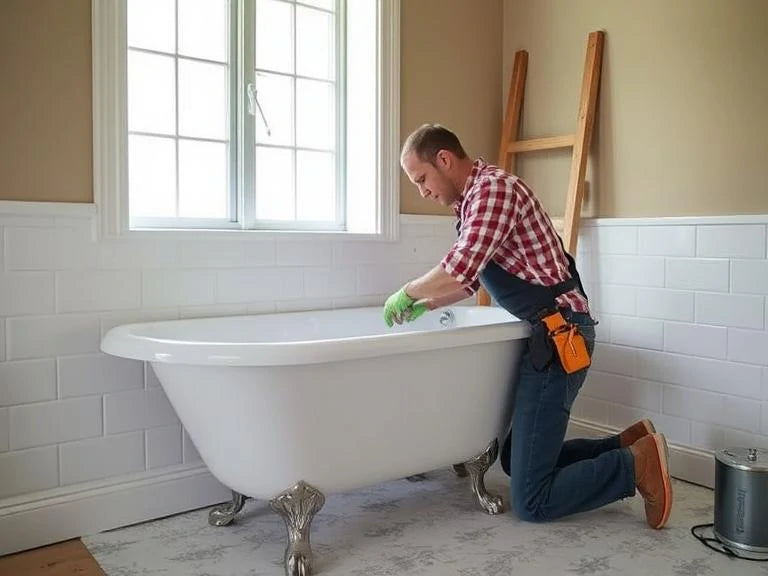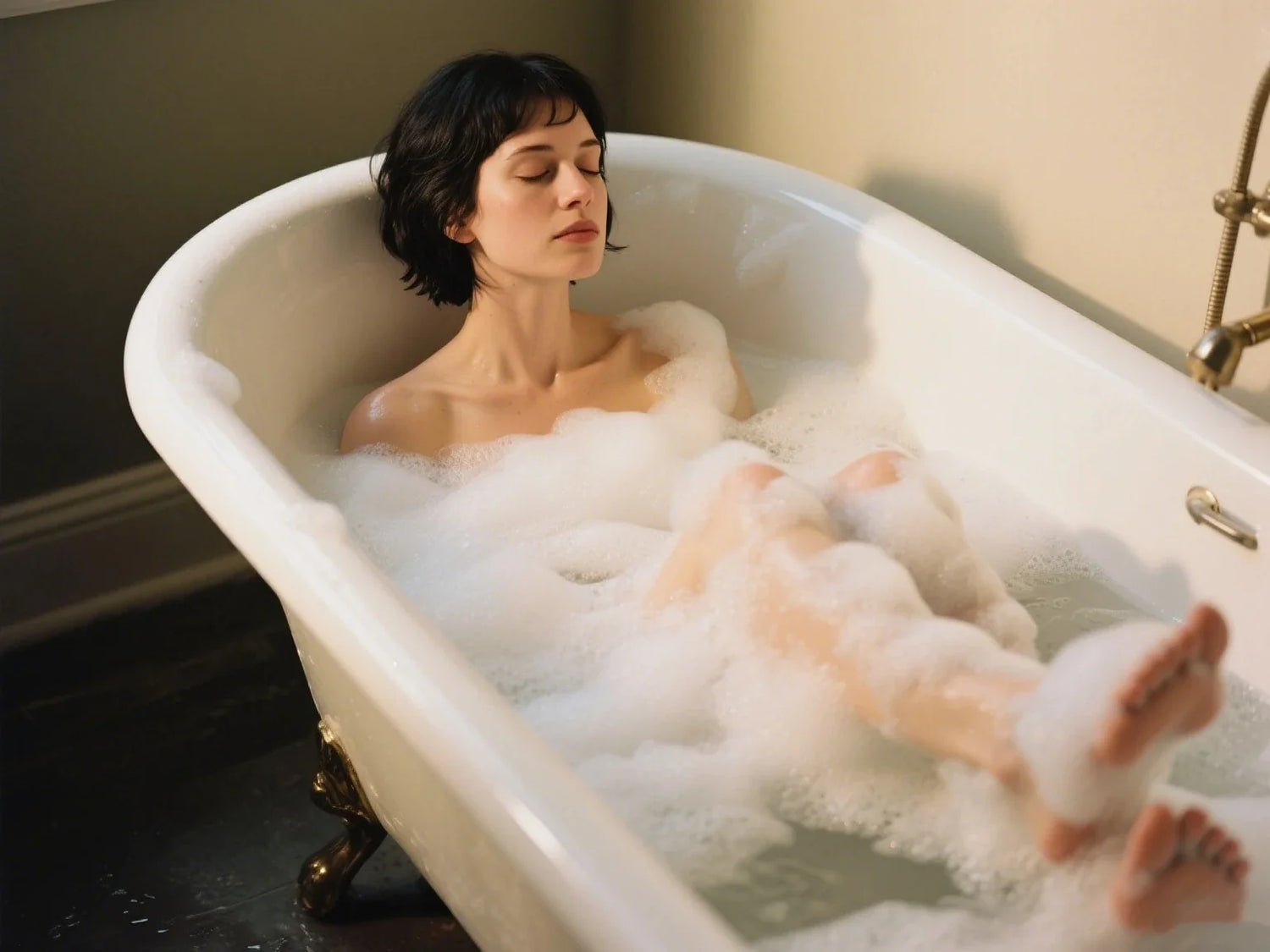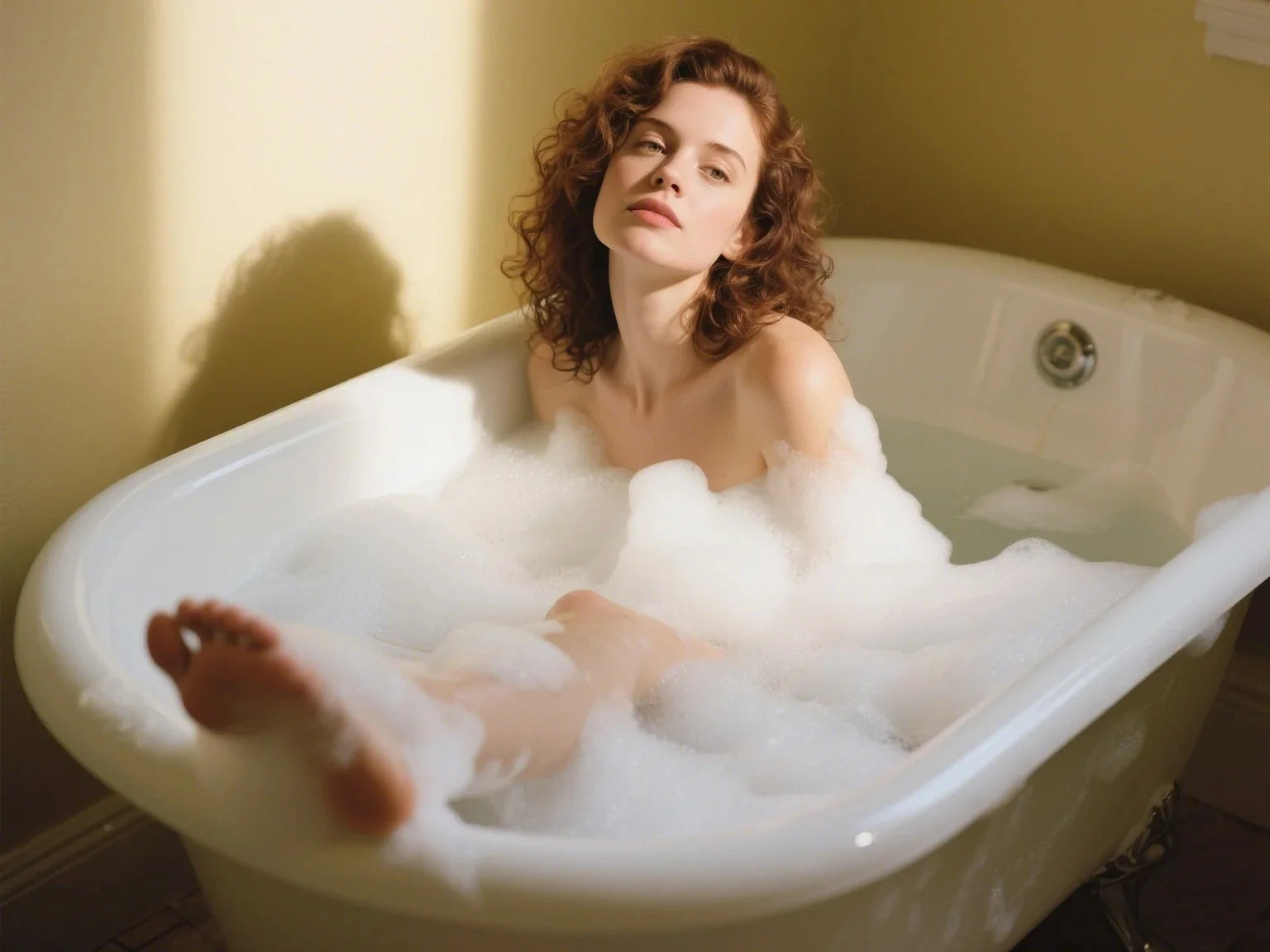A cast iron clawfoot tub represents more than a bathroom fixture since it embodies classic elegance and enduring craftsmanship. The durability and heat retention properties along with timeless appeal make this bathtub type a preferred choice among homeowners who want equal luxury and functionality. The claw foot cast iron tub stands out as a bathroom centerpiece because it combines exceptional style with remarkable substance in any bathroom design from vintage to contemporary. This article examines the advantages and disadvantages of claw foot cast iron tubs along with installation considerations and material comparisons to help you decide if this classic fixture suits your home.
Introduction to Cast Iron Clawfoot Tubs
The cast iron clawfoot tub originated in the 19th century as a luxurious item in aristocratic homes. The freestanding design of this bathtub with its ornate claw feet for bathtubs made it a staple in well-appointed bathrooms. The claw foot cast iron tub remains a symbol of elegance and sophistication which people choose for both antique restorations and contemporary reinterpretations. The claw foot cast iron tub achieves superior strength and longevity and visual appeal through its thick enamel coating on cast iron construction. The clawfoot bathtub endures as a design element that resists the passage of time despite changing design trends.

Benefits of a Cast Iron Clawfoot Tub
The value of a cast iron clawfoot tub becomes clear when we examine its multiple advantages. The tub offers multiple advantages which include both visual appeal and operational excellence and long-term financial benefits to make it an attractive option for sophisticated homeowners.
Durability and Lifespan
Bathroom fixtures require durability as their primary consideration. The cast iron clawfoot tub stands out for its exceptional durability because it features a robust cast iron construction. Cast iron maintains its shape and structural integrity throughout decades because it does not experience the same cracking or flexing issues that lighter materials do. Proper maintenance allows a clawfoot tub to survive more than 70 years which makes it one of the longest-lasting bathtub options in the market.
The enamel finish protects the surface from everyday wear by providing resistance to scratching and staining. The long-lasting finish protects your clawfoot bathtub from damage so it will look beautiful and shiny even after many years of use. Its durability makes it a valuable investment for both residential bathrooms and luxury hotel suites.
The structure provides stability as one of its main advantages. The claw foot tub maintains its position without movement or creaking when filled which creates a stable and comforting bathing experience that enhances luxury. Homeowners select this tub over modern alternatives because of its solid construction.
Heat Retention
A cast iron clawfoot tub retains heat as one of its most cherished characteristics. The combination of dense cast iron material with enamel insulation keeps the water inside the tub warm for an extended period compared to acrylic or fiberglass tubs.
The exceptional heat retention feature makes the soaking experience better. The bath stays warm which helps users relax while minimizing the need to add hot water repeatedly. The ability to retreat into the tub makes this benefit essential for those who consider the tub their sanctuary.
The clawfoot tub with shower combination provides practical value for shared bathrooms. The traditional soaking experience of this tub allows modern shower installation while maintaining water temperature and comfort standards.
Timeless Aesthetic Appeal

The cast iron clawfoot tub exists as a design element that serves both practical and aesthetic purposes. The classic design combined with its ornate claw feet for tub creates a unique bathroom aesthetic. The tub stands out in any bathroom setting regardless of whether you select a white finish or a bold color choice.
Another advantage lies in the design versatility of clawfoot bathtubs as they come in a variety of finishes and foot styles such as lion’s paw and vintage scrollwork to suit decor themes ranging from Victorian, to contemporary minimalism.
The clawfoot bathtub for sale serves as a central design element which interior designers use to create bathroom layouts. The bathtub stands alone to create a luxurious sanctuary while elevating the room's aesthetic value. A claw foot bathtub feels more like a centerpiece than a utility item when properly surrounded.
Increased Home Value
A cast iron clawfoot bathtub purchase will also increase your home's value. Real estate listings often include these tubs as luxury features which buyers consider as upgrades. The classic design and premium materials of these tubs attract homebuyers who want both functionality and elegance in their bathrooms.
The antique claw foot tub stands as a highly sought-after feature for potential homeowners who value its rarity and worth especially when it remains in good condition or has been recently restored. The inclusion of this feature in your bathroom will make your property more distinctive in a crowded housing market.
Luxury properties benefit from a clawfoot tub because they enhance other premium features to create an elegant and sophisticated space. The combination results in increased appraisal values and attracts buyers who value design.
Downsides of a Cast Iron Clawfoot Tub
The cast iron clawfoot tub provides numerous benefits yet it comes with specific difficulties. The knowledge of these limitations helps buyers make better purchasing decisions.
Heavy Weight and Floor Reinforcement Needs
The main disadvantage of cast iron clawfoot bathtubs is their heavy weight. These tubs weigh between 300 to 500 pounds when they are empty. The total weight of the tub and water and person exceeds 800 pounds.
The tub's weight requires your house to undergo structural modifications when you plan to install it on an upper floor level. The installation of floor joist reinforcement and proper support requires professional expertise. The additional requirement makes the installation process more complicated and expensive.
The process of installing clawfoot bathtubs becomes challenging when it comes to moving them into bathroom spaces. The delivery process becomes complicated by tight hallways and narrow door frames and staircases which may need specialized equipment or house part disassembly.
High Cost of Purchase and Installation
The price of the product should also be considered. The price of a quality cast iron clawfoot tub for sale can range from $1,000 to $5,000 or more. The shipping, delivery, and installation costs are not included in the total price and can add another $500 to $2,000 to the total.
The tub requires professional labor because of its weight and plumbing needs and floor reinforcement requirements. Homeowners need to plan their budget accordingly because installing the tub requires more work than simply placing it in position.
The total investment will increase when homeowners choose high-end finishes including brushed nickel or antique bronze claw feet for tub. The price of these beautiful upgrades exceeds what some homeowners want to spend.
Potential for Chipping and Rust

The enamel coating on a cast iron clawfoot bathtub is extremely durable, but it is not invincible. Heavy objects dropped into the tub can chip the surface, exposing the underlying iron.
The metal starts to rust after exposure particularly when it is placed in humid conditions. Enamel patch kits can fix small chips but professional refinishing becomes necessary for bigger damage.
The use of abrasive materials for cleaning will eventually damage the enamel surface. The clawfoot tub requires proper maintenance to maintain its beauty and functionality throughout the years.
Lead Exposure in Antique Tubs
The original finishes of vintage and antique tubs typically include lead-based materials. Before using an antique claw foot tub you should have it tested for lead content.
Older tubs are often refinished as a standard practice. The process requires the removal of the original enamel before applying a new lead-free modern coating. The process proves effective yet increases both expenses and upkeep requirements.
When purchasing clawfoot bathtubs for sale, buyers should ask about the product history and any past refinishing procedures. The seller's openness about the product will help you obtain a safe and durable purchase.
Cast Iron Clawfoot Tub vs. Other Bathtub Materials
The evaluation of old-fashioned clawfoot tub strengths requires comparison with other bathtub materials. The comparisons reveal the distinctive features of cast iron.
Acrylic vs. Cast Iron Clawfoot Bathtub
Acrylic tubs continue to be popular because they are affordable and lightweight. The installation process is simple and these tubs are available in numerous design options. Cast iron clawfoot tubs provide superior heat retention and durability compared to acrylic tubs.
Acrylic tubs have a lighter structure which causes them to move and flex when used. The repeated use of acrylic tubs results in the development of cracks and soft spots. The cast iron material used in clawfoot bathtubs creates a firm and unshakeable bathing platform.
Acrylic bathtubs are prone to scratching and may change color as they age while cast iron is considered the top choice, for those who prioritize durability and visual appeal despite the higher initial cost.
Steel vs. Cast Iron
Steel tubs provide a balance between acrylic and cast iron options. Being lighter than cast iron yet sturdier, than counterparts; however they lack in heat retention and resistance to chipping.
The thin enamel layer on steel makes it more susceptible to surface damage. The quick rusting of steel after chipping can lead to structural damage of the tub.
The old-fashioned clawfoot tub provides longer lifespan and better appearance and insulation compared to steel. Homeowners who want to purchase a bathtub that will last their lifetime should choose cast iron as their top option.
Fiberglass or Resin Alternatives
Fiberglass and resin tubs attempt to duplicate the appearance of a claw foot bathtub without the weight and cost. The budget-friendly appeal of these options comes at the expense of performance.
These materials are less durable and may show signs of wear within a few years. The enamel-coated cast iron has a sturdy feel and luxurious finish which these materials do not have.
Fiberglass alternatives provide lower satisfaction levels and resale value compared to claw foot cast iron tubs although they function adequately for short-term installations or secondary bathrooms.
Installation of a Cast Iron Clawfoot Tub
Selecting a cast iron clawfoot tub requires more than picking a design. The installation process demands careful planning and professional assistance together with thorough examination of structural elements and plumbing systems.

Floor Load Requirements
The installation of a clawfoot bathtub requires a floor assessment to determine its weight-bearing capacity. A structural engineer or contractor should be consulted for this assessment.
The installation of additional joists or supports will be required in most situations. The floor structure will benefit from both safety and extended lifespan because of this concentrated weight.
The modifications become essential for multi-story homes because the bathtub installation will occur above ground level. The floor needs proper reinforcement to avoid expensive damage that will occur in the future.
Plumbing and Positioning Considerations
The freestanding claw foot cast iron tub requires customized plumbing solutions. These tub models require floor-mounted faucets and exposed drain lines because they are not built into the floor.
The installation cost and overall appearance of the setup are affected by this configuration. Homeowners choose vintage-style fixtures because they match the clawfoot tub design.
The correct placement of elements serves as a fundamental principle to develop both functional and visually attractive designs. The tub requires sufficient surrounding space for cleaning purposes and to create an independent visual effect.
Delivery and Handling Logistics
Moving an antique clawfoot bathtub into your home presents significant logistical difficulties. The bathtub's large size and heavy weight demands specialized professional movers who possess appropriate equipment.
The tub installation process may require you to take out doors and banisters for proper bathroom entry. The added complexity needs to be included in your project timeline and budget calculations.
The process of advance planning helps prevent delays and damage from occurring. Your tub will arrive safely without incident when you work with experienced delivery teams.
Cost Overview of Cast Iron Clawfoot Tubs
The financial aspects of buying a cast iron clawfoot tub extend beyond its visual appeal and operational capabilities. Let’s explore what to expect.
Price Range of Cast Iron Clawfoot Tubs
The starting price for a quality cast iron clawfoot tub for sale is around $1,000 and can reach up to $5,000 or more based on brand, size and customization.
The price of bathtubs increases when you move to more complex models that include claw feet for bathtubs or double-ended designs. Antique versions that are fully restored may command premium prices.
Opt for priced options may lead to thinner enamel or subpar durability in the long run whereas investing in a well known brand will ensure a durable product that lasts longer.
Cost of Installation and Reinforcement
The installation expenses for a cast iron clawfoot tub depend on local labor costs together with the extent of work required. The total cost of structural reinforcement and plumbing setup and finishing touches tends to increase rapidly.
The cost for professional installation of tubs ranges between $500 and $2,000 on average. The installation process requires both time and specialized tools and expert knowledge to correctly position and secure the tub.
Hiring skilled tradespeople is essential. Poor installation can lead to leaks, floor damage, or even structural failure over time.
Refinishing and Resale Value
Older tub owners can achieve a cost-efficient restoration of their tub through refinishing. A professional antique claw foot tub restoration process will make the tub appear brand new while maintaining its original functionality.
The cost of refinishing depends on the condition and size of the item and typically ranges from $300 to $900. The process requires removing the existing enamel before fixing any damage and then applying a new durable finish.
A refinished claw foot tub functions as a bathing centerpiece that provides both a historical charm and full functionality to enhance your home's resale value.
Maintenance and Cleaning of Cast Iron Clawfoot Tubs
Regular maintenance is necessary to preserve the elegance of your cast iron clawfoot tub. Simple maintenance practices will help you preserve the beauty of your clawfoot tub for many decades.
Daily Cleaning Tips
The enamel finish should be protected from abrasive scrubbers and harsh chemicals that could cause erosion. The surface should be cleaned with mild soap and a soft cloth after each use.
The process of drying the tub after bathing serves two purposes: it stops water stains from forming and prevents mineral deposits from accumulating. The drying process minimizes the risk of slipping while maintaining both the appearance and operational capabilities of the tub.
Regular upkeep serves two purposes by maintaining the appearance of a new tub while protecting it from future damage. A clean clawfoot bathtub enhances the overall ambiance of your bathroom.
Dealing with Rust and Chips
You should fix any enamel chip right away. Cast iron exposed to the air will rust rapidly when it is placed in humid conditions.
Use an enamel repair kit for small chips, or hire a professional for more extensive repairs. Taking prompt action helps maintain both the structural integrity and appearance of your antique clawfoot bathtub.
The surface needs to remain pristine because this will allow continued use and extend the lifespan of the tub.
Long-Term Care
Regular inspections and maintenance are essential. Check the legs, floor mounting, and plumbing connections periodically to ensure everything remains secure.
Check the shower attachment hardware on your clawfoot tub for leaks or mineral buildup. Regular inspections help prevent water damage and keep the area clean.
Your cast iron clawfoot bathtub will continue to serve as a luxurious retreat and home pride for generations with proper care.
The Appeal of a Clawfoot Tub Beyond Functionality
The cast iron clawfoot tub serves both functional purposes and maintains a special position in interior design and historical charm.
Historical and Aesthetic Value

These tubs connect us to a past era when bathing was considered a luxurious ritual. An antique claw foot tub adds depth and character to any space.
Their classic design continues to be fashionable because it adapts to different interior styles while maintaining its everlasting beauty. A claw foot bathtub placed correctly creates an elegant atmosphere which modern fixtures cannot replicate.
The classic clawfoot bathtub continues to be a popular choice for those interested in vintage and sustainable design.
Customization with Claw Feet and Finishes
The modern clawfoot bathtubs provide various customization choices. The selection includes polished chrome and antique bronze claw feet for tub which match different personal preferences.
The tub can be painted with exterior colors that match your decor to create either a harmonious blend or a bold statement piece.
The customization options allow each clawfoot bathtub to become distinctive through features that match the homeowner's individual style and design preferences.
Shower Compatibility
People commonly believe that cast iron clawfoot tubs cannot work with contemporary amenities. The cast iron clawfoot tub can be adapted to use a shower ring together with an overhead shower head.
The hybrid design allows users to experience the comfort of soaking while maintaining the convenience of showering which makes the clawfoot tub with shower perfect for households with multiple users or shared bathroom spaces.
The tub's adaptability enhances its market value because it serves both decorative and functional purposes.
Conclusion: Is a Cast Iron Clawfoot Tub Worth It?
Homeowners who want luxury combined with durability and visual appeal should consider the cast iron clawfoot tub as their top selection. The initial investment for this product along with its installation needs careful planning but its extended advantages make it worth the expense. Proper maintenance allows this product to deliver comfort and elegance and functional beauty throughout its entire lifespan.
FAQ
1. What is the disadvantage of a cast iron tub?
The main disadvantages of a cast iron tub include its substantial weight, which may require floor reinforcement, its high installation and transportation costs, and the potential for enamel chipping that can expose the underlying iron to rust. These tubs also pose challenges in terms of delivery logistics and are less suitable for homes with weaker floor structures.
2. Are clawfoot tubs worth money?
Clawfoot tubs maintain their value because they possess enduring design elements and long-lasting construction and create luxurious bathroom spaces. A well-preserved antique claw foot tub or a modern well-maintained version enhances both the market value and visual appeal of upscale homes and properties with historical design elements.
3. How much does it cost to refinish a cast iron clawfoot tub?
The cost of refinishing a cast iron clawfoot tub ranges between $300 and $900. The process of refinishing includes removing old enamel layers and fixing any surface issues before applying fresh enamel coatings. Professional refinishing services both restore the tub's appearance and extend its lifespan by adding multiple decades to its operational period.
4. What is the life expectancy of a cast iron bathtub?
A cast iron clawfoot tub that receives proper care will survive for 50 to 100 years. The thick cast iron body and durable enamel coating make it one of the longest-lasting bathtub materials on the market, provided it is protected from chipping and maintained properly over time.
5. Do cast iron tubs chip easily?
The enamel coating on cast iron tubs is durable, but it can chip if subjected to heavy impacts. Care should be taken to avoid dropping heavy objects into the tub.
6. Why do people love clawfoot tubs?
People value clawfoot tubs because they combine classic beauty with deep soaking capabilities and serve as bathroom design centerpieces. The freestanding design of these tubs enables different placement options throughout the bathroom space.








Leave a comment
This site is protected by hCaptcha and the hCaptcha Privacy Policy and Terms of Service apply.